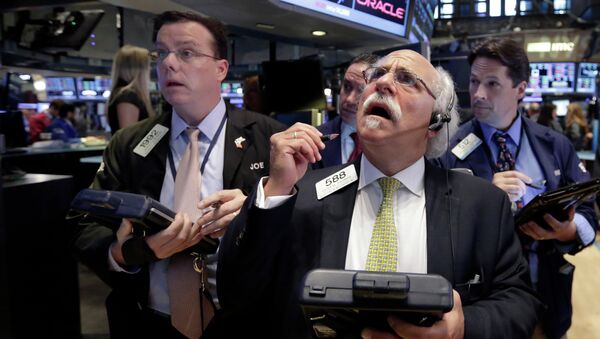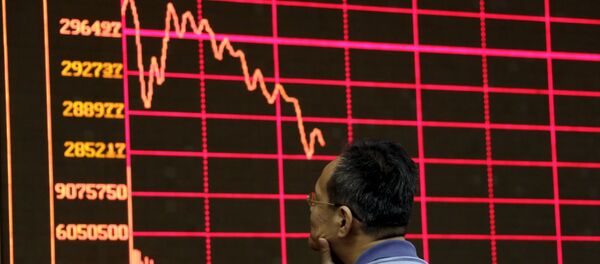Kristian Rouz — In Wednesday's trading, Wall Street posted a massive rally across sectors in a best one-day rise since 2011, with investors rushing into the greatly depreciated US stocks. After having tumbled up to 10% in six consecutive days of losses and losing roughly $2.1 trln in market value (compared to China's losses of about $5 trln), US stock market has seemingly developed sustainability against the overseas risks, besides, the monetary authorities in Washington signaled the anticipated September rate hike is hardly a possibility now. The doubt is still there, however, if the world is facing another economic depression whilst the prospect of only a mediocre growth being a more optimistic scenario, are the US able to withstand a yet another global challenge?
The Dow Jones Industrials Average Index rose 619.07 points, or 3.95% to 16,285.51 points, while the S&P 500 added 72.90 points (3.90%) to 1,940.51 points. The tech-driven Nasdaq Index rose 4.24%, or 191.05 points, to 4,697.54, as a rally in Silicon Valley giants Apple, Google and Amazon propelled the broader market higher.
A reassuring signal came from the New York Fed President William Dudley, who noted that given the global turmoil and the increased volatility in mainland China, while the growth elsewhere is slower, the prospect for a September rise in borrowing costs in the US is ‘less compelling'. With overseas factor having such a significant impact on the US monetary policy, however, the statement raised questions of whether the US economy could withstand a full-scale collapse of the Chinese economy, if that is to happen.
US market volatility index VIX dropped to 30 after skyrocketing on Monday to its 6.5-year highest of 53.3. The measure, known as ‘fear index', Is still above its multiyear average of 10-12, meaning there is much uncertainty, both of the further US Fed steps, and the developments in overseas markets and broader economies.
Many market participants have noted the rally was more of a surprise, especially so given that morning trading was uneven, with most shares either flat of wavering between gains and losses, but afternoon trading saw a surge in the tech sector.
In macro data, a more optimistic than expected index of US business investment supported the rally. Demand for heavy duty industrial goods also rose above expectations in July, with June's reading been revised upward as well. US manufacturing is gaining momentum, nit least at the expense of mainland China's freezing industrial production as a reshoring of American industries is going full-steam.
US stocks remain vulnerable though due to their high exposure to overseas risks. Many shares dropped below their psychological thresholds, meaning it will be hard to restore market confidence from this point. After the US equity market lost $2.1 trln in value, returns expectations are lower, and there are many questions regarding the commercial performance of US enterprises.
While the British financial giant Barclays rose its Q3 growth forecast for the US economy to 2.8% year-on-year, the economy is far from being a prosperity. The US debt is standing at 74%, according to Congressional Budget Office (CBO) estimate published Tuesday, and an increased social spending impairs the government's ability to stimulate economy via tax cuts, more so as the debt is poised to rise further. That is a concern, given the US debt stood at 35% GDP in 2007, however, even now it is still way below that of mainland China (280%) or the eurozone (91.9%).
With the aforementioned fiscal and monetary policy implication, the US are largely deprived of its conventional and unconventional anti-crisis tools. This explains why the Obama administration is steadily pushing the US economy toward becoming more self-sustainable: the less the overseas impact, the better the domestic economic outlook.
Nonetheless, the monetary and fiscal challenges must be timely addressed with a more decisive action on rate hike and balancing the federal budget — just in case the global economic meltdown arrives before the US reach an appropriate level of self-sustainability.





